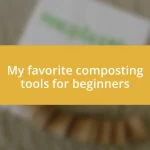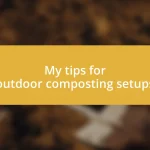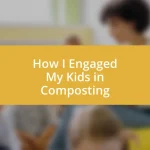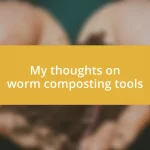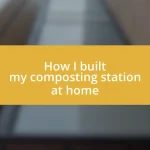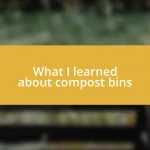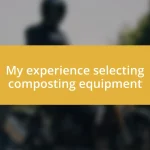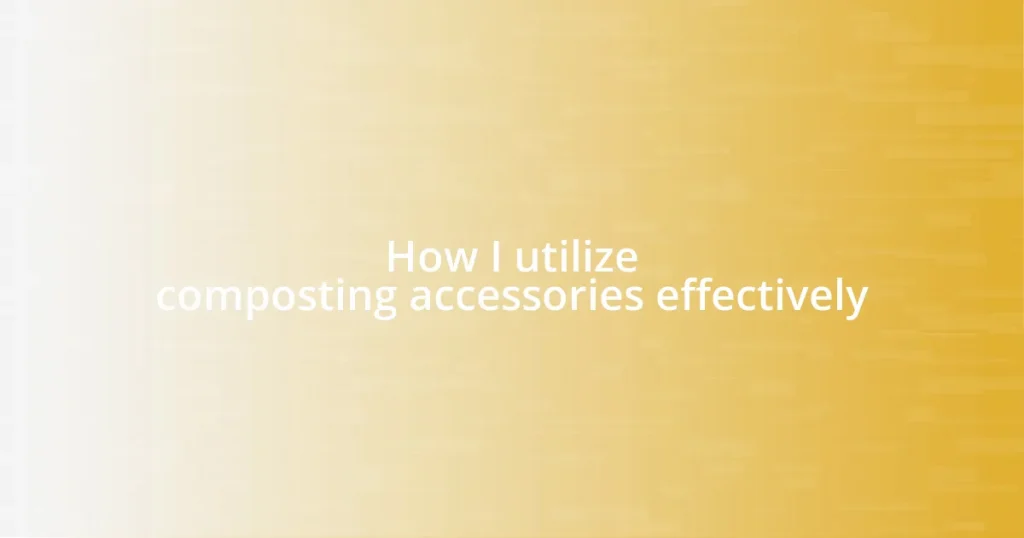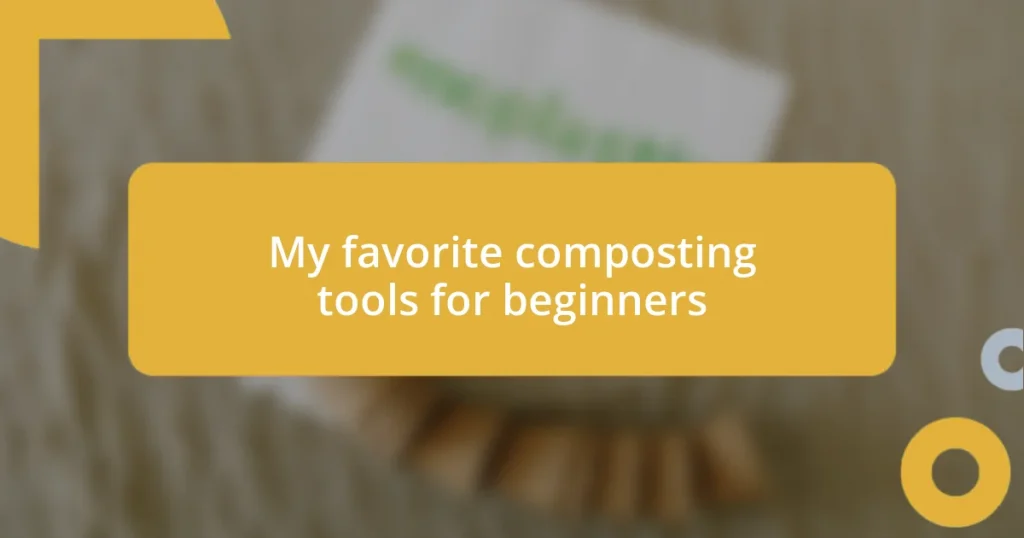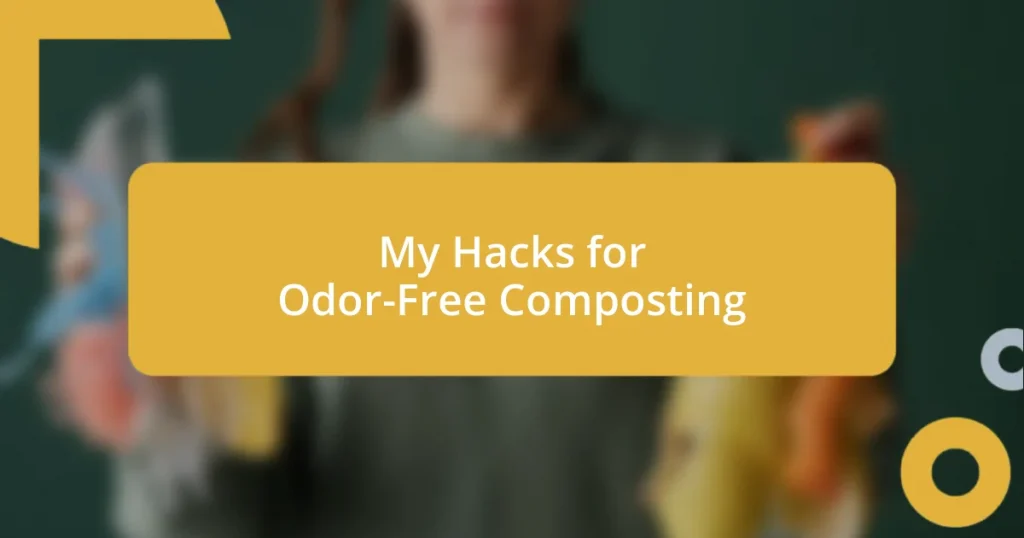Key takeaways:
- Choosing a convenient, sunny location for composting accelerates breakdown and minimizes odors.
- Maintaining a balance of “greens” and “browns” in compost and monitoring moisture and temperature are crucial for successful decomposition.
- Expanding composting practices to include community involvement and different techniques, like vermiculture, enhances sustainability efforts.

Choosing the right location
Finding the perfect spot for your composting station can feel like a mini adventure. When I was scouting locations in my backyard, I discovered that proximity to my kitchen was crucial. Let’s face it, who wants to trek across the yard with scraps in hand? It quickly became clear that convenience could make all the difference in how frequently I added to my compost.
I also learned that sunlight plays a vital role in the composting process. When I first set mine up in a partially shaded area, I noticed it took longer for the materials to break down. Did I really want to wait? Ultimately, I moved it to a sunnier spot, and watching the process speed up was incredibly satisfying. It was like the composting gods smiled down on me!
Lastly, consider the smell. I was tempted to tuck my composting station away in a corner, but then I thought about the neighbors. I made sure to place it in a spot where I could easily manage any odors, which has turned out to be a fantastic decision. Have you thought about how the location might affect your daily life?

Selecting composting materials
When it comes to selecting composting materials, I found that balancing “greens” and “browns” is essential. Greens, like vegetable scraps and coffee grounds, provide nitrogen, while browns, such as dried leaves and cardboard, supply carbon. In my early days, I tended to favor one over the other, and my compost often became too wet or too dry. Finding that balance truly transformed my composting experience!
I also discovered that certain materials can be a bit trickier than others. For instance, while meat and dairy might seem like they’d break down well, they can attract pests and create odors. I remember my first attempt at composting banana peels and eggshells, which turned out fine, but I learned quickly that adding anything complex required more thought. Have you thought about which materials you might want to avoid?
Finally, size matters in composting. Chopping larger items into smaller pieces can help speed up the decomposition process. I initially tossed in whole fruit skins, but after seeing how long they took to decay, I started cutting them into smaller chunks. That simple tweak made a noticeable difference in the quality of my compost! Let me share some insights in table form that might help you visualize what works best.
| Composting Materials | Type |
|---|---|
| Vegetable Scraps | Green |
| Dried Leaves | Brown |
| Eggshells | Green |
| Meat | Avoid |
| Coffee Grounds | Green |
| Cardboard | Brown |

Building the compost bin
Building a compost bin can be both exciting and rewarding. When I decided to create my own, I opted for a simple wooden structure. I found that using untreated wood was essential, as I wanted to avoid introducing any chemicals into my compost. The act of assembling the frame felt like a creative project, and I even involved my kids, turning it into a fun weekend activity. Seeing their enthusiasm reminded me how important it is to share eco-friendly practices with the next generation.
Here are a few key tips I found helpful when building my compost bin:
– Dimensions: Aim for a bin that is about 3 feet wide, 3 feet tall, and 3 feet deep. This size offers a manageable space while retaining heat and moisture.
– Airflow: Ensure your bin has openings or slats for proper aeration. I initially used solid boards, but this change made a noticeable difference in decomposition speed.
– Ease of access: Adding a hinged door or a removable panel allows for easy turning and monitoring. I learned the hard way that struggling to dig into a tightly sealed bin was a recipe for frustration!
– Temperature monitoring: Consider adding a thermometer to check the internal temperature. I found that keeping it around 130°F to 160°F created the perfect environment for microorganisms to thrive.
– Personal touch: Customizing your bin with decorations can make composting feel more personal. I painted ours with fun colors, which surprisingly encouraged both my family and neighbors to take an interest.
Building my compost bin turned into more than just a project; it became a space where I felt connected to nature and my family. It bridged the gap between sustainability and creativity in a fun and meaningful way.

Maintaining the compost pile
Maintaining the compost pile is where the real magic happens. I discovered that turning the pile every few weeks not only aerates it but also speeds up decomposition. The first time I turned my compost, I felt a rush of excitement as I unearthed rich, dark soil. It made me realize how dynamic the process truly is. Have you ever tried turning your compost and found an unexpectedly pleasant smell? It’s rewarding and can feel like unearthing a treasure!
Another aspect I learned is the importance of moisture. It’s crucial to maintain a damp environment, similar to a wrung-out sponge. During my first summer, I faced the challenge of a dry pile, which led to slower breakdown. Now, I keep a hose nearby and give it a sprinkle whenever it starts looking too dry. I often think about how our own gardens thrive when nourished properly, and compost is no different.
Lastly, I keep a close eye on the temperature of the compost pile. I always aim for that “sweet spot” between 130°F and 160°F, which is effective for killing off pathogens and weed seeds. When I added a simple thermometer, it became a bit of a game for me – tracking the daily highs and lows. It’s fascinating to think about the bustling life happening in that pile, with microorganisms working tirelessly. Is there something more rewarding than being nature’s partner in this process? Each time I check, I find a renewed appreciation for the cycle of life.

Troubleshooting common issues
Sometimes, the compost pile doesn’t behave as you’d expect. I remember the first time I noticed my compost was giving off a terrible odor. It turned out I had an imbalance: too much nitrogen from kitchen scraps and not enough carbon from dried leaves. Adjusting the mix made a world of difference, and now every time I catch a whiff of earthy goodness, I smile, knowing I’ve fostered a thriving ecosystem instead.
If you notice your compost pile is too wet, it’s crucial to take action quickly. One rainy afternoon, I realized my pile was soggier than a wet sponge. I grabbed some dry straw and mixed it in, which helped soak up the extra moisture. I often think about how all elements in nature seek balance; just like our emotional lives, the right mix is essential for healthy compost.
Pests can also become an issue, especially if your pile attracts unwanted visitors. There was a time I found my compost crawling with ants – not exactly the team I was hoping for! Covering kitchen scraps with a layer of browns like shredded paper or cardboard helped deter them. Think of it as creating a cozy bed for your compost. Who knew that little adjustments could lead to such big differences in the health of your pile?

Using finished compost in garden
Using finished compost in your garden is like giving your plants a nutrient-rich hug. I remember the first time I spread my homemade compost around my flower beds. As I watched the plants perk up, it became clear that this natural amendment works wonders. Isn’t it amazing how the earth can transform waste into life-giving nourishment?
Incorporating compost into the soil has massively improved my vegetable yields. I recall last summer, I mixed in a generous amount of finished compost before planting my tomatoes. The result? Juicy, robust fruits that I couldn’t stop sharing with friends. Who wouldn’t want to experience such a bountiful harvest?
One of my favorite practices is using compost as a top dressing for my garden beds. It’s easy and feels rewarding to see the vibrant contrast it creates against the soil. Each time I sprinkle a fresh layer, it’s like a natural fertilizer that keeps on giving. Plus, it helps retain moisture, which I found incredibly helpful during dry spells. Have you ever tried this? If not, I highly recommend it; your plants will surely thank you!

Expanding composting practices
As my composting journey evolved, I discovered various techniques to expand my practices beyond just the backyard bin. For instance, I started a worm composting setup, known as vermiculture, which has been a delightful experience. Watching those little wigglers transform kitchen scraps into rich “black gold” added a whole new layer of excitement to my composting routine—it’s like having nature’s own recycling team right in my home!
Another rewarding aspect of my composting adventure has been sharing the knowledge and materials with my neighbors. Picture this: one afternoon, I set up a compost exchange day, where everyone brought their organic waste while taking home some finished compost. It was heartwarming to see the community come together, engaging in discussions, and swapping tips. Isn’t it fascinating how something as humble as compost can foster connections and inspire others to embrace sustainable practices?
I’ll never forget the day I decided to implement composting at my workplace. After introducing a small compost bin in the break room, the positive response from my coworkers was overwhelming. Their curiosity turned into enthusiasm, and before I knew it, we had established a collaborative composting effort that not only reduced waste but also sparked conversations about sustainability in our daily lives. Have you ever thought about how your composting initiatives could extend beyond your home? The impact can be truly transformative!

